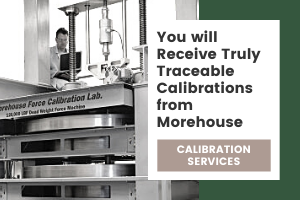5 Common Types of Load Cells
In the last Back-to-Basics blog, I covered Load Cell Terminology. As I continue to cover basic concepts for beginners, this blog details the common load cell types used in force measurement and how to choose the right load cell type for your application.
The four types of load cells typically used in force measurement are bending beam, shear beam, miniature, and column. We are going to describe the common load cell types we see used as reference and field standards below. Many of the other load cells shown are found in more commercial applications such as scales used at supermarket checkouts, weight sensing devices, weighing, and other scales.
Load Cell Types
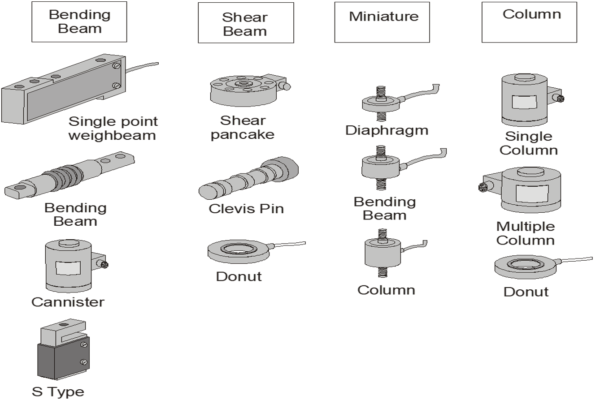
S-beam (S-type)
The S-beam is a bending beam load cell that is typically used in weighing applications under 50 lbf. These load cells work by placing a weight or generating a force on the load cell's metal spring element, which causes elastic deformation. The strain gauges in the load cell measure the fractional change in length of the deformation. There are generally four strain gauges mounted in the load cell.

Advantages
- In general, linearity will be enhanced by minimizing the ratio of deflection at the rated load to the length of the sensing beam, thus minimizing the change in the shape of the element.
- Ideal for measuring small forces (under 50 lbf) when physical weights cannot be used.
- It is suited for scales or tension applications.
Disadvantages
- The load cell is very sensitive to off-axis loading. A video demonstrating this misalignment can be found here.
- Compression output will be different if the load cell is loaded through the threads versus flat against each base.
- Typically, not the right choice for force applications requiring calibration to the following standards: ASTM E74, ASTM E4, ISO 376, and ISO 7500.
Shear Web
The shear web is a shear beam load cell that is ideal as a calibration reference standard up to 100,000 lbf. Morehouse shear web load cells are typically the most accurate when installed on a tapered base with an integral threaded rod installed.
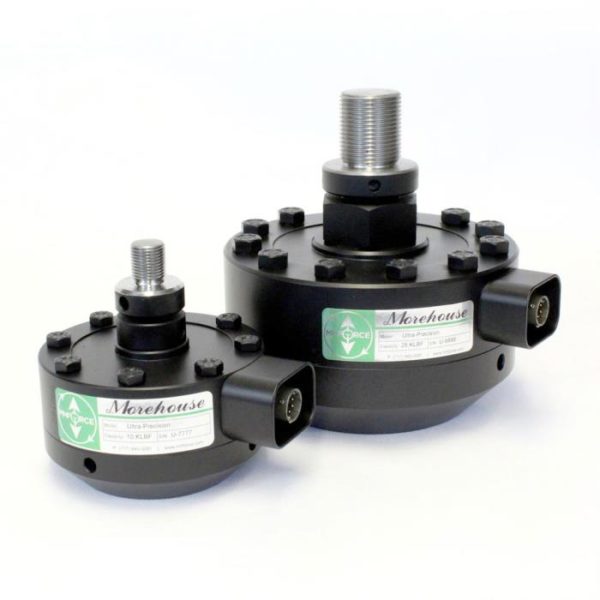
Advantages
- Typically have very low creep and are not as sensitive to off-axis loading as the other load cells. A video showing only 0.0022 % off-axis error can be found here.
- Recommended choice for force applications from 100 lbf through 100,000 lbf.
Disadvantages
- After 100,000 lbf, the cell's weight makes it very difficult to use as a reference standard in the field. A 100,000 lbf shear web load cell weighs approximately 57 lbs, and a 200,000 lbf shear web load cell weighs over 120 lbs.
Note: If this load cell is used without a base or without an integral top adapter, there may be significant errors associated with various loading conditions. A video showing errors from not having an integral top adapter can be found here.
Button Load Cell
The button is a miniature load cell that is typically used when space is limited. It is a compact strain gauge-based sensor with a spherical radius that is often used in weighing applications.
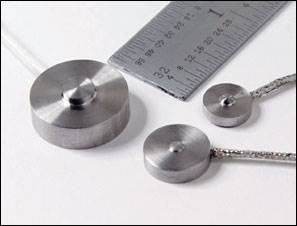
Advantages
- Suitable for applications where there is minimal room to perform a test.
Disadvantages
- High sensitivity to off-axis or side loading. The load cell will produce high errors from any misalignment. A 0.1 % misalignment can produce a large cosine error. Some have errors anywhere from 1 % - 10 % of rated output.
- Do not repeat well in the rotation.
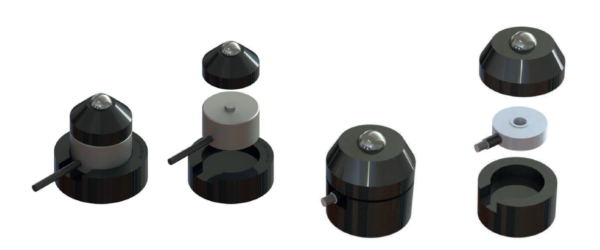
Morehouse has developed custom adapters for button, washer, and donut load cells that improve repeatability. In our testing, we achieved a 525 % improvement using the above adapters. If your laboratory calibrates these types of load cells and observes the same repeatability problems, please contact Morehouse as the above adapters will improve the calibration results.
Single-Column or High-Stress Load Cells
The single column is a column load cell that is good for general testing. The spring element is intended for axial loading and typically has a minimum of four strain gauges, with two in the longitudinal direction. Two are oriented transversely to sense the Poisson strain. The Morehouse single-column load cell is economical and lightweight.
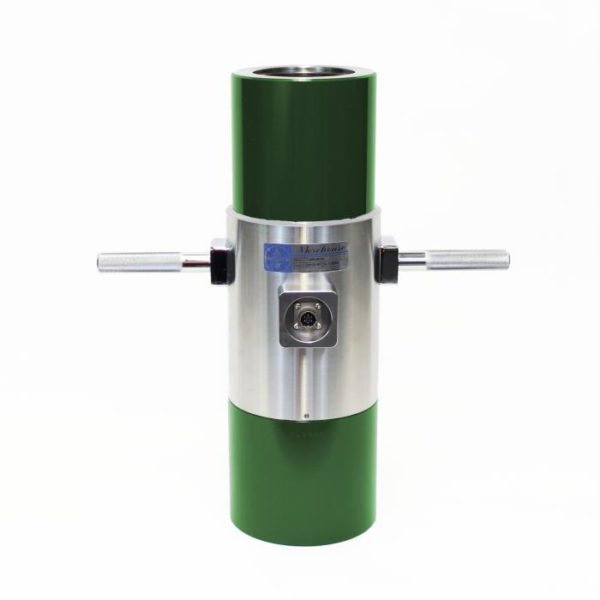
Advantages
- Physical size and weight: It is not uncommon to have a 1,000,000 lbf column cell weigh less than 100 lbs.
Disadvantages
- Reputation for inherent non-linearity. This deviation from linear behavior is commonly ascribed to the change in the column's cross-sectional area (due to Poisson's ratio), which occurs with deformation under load.
- Sensitivity to off-center loading can be high.
- Larger creep characteristics than other load cells and often do not return to zero as well as other load cells. (ASTM Method A typically yields larger LLF)
- Different thread engagement can change the output.
- The design of this load cell requires a top adapter to be purchased with it. Varying the hardness of the top adapter will change the output.
Multi-Column Load Cells
The multi-column is a column load cell that is good from 100,000 lbf through 1,000,000 plus lbf. In this design, the load is carried by four or more small columns, each with its own complement of strain gauges. The corresponding gauges from all the columns are connected in a series in the appropriate bridge arms. The Morehouse multi-column 600K load cell weighs 27 lbs and has an accuracy of better than 0.02 % of full scale.
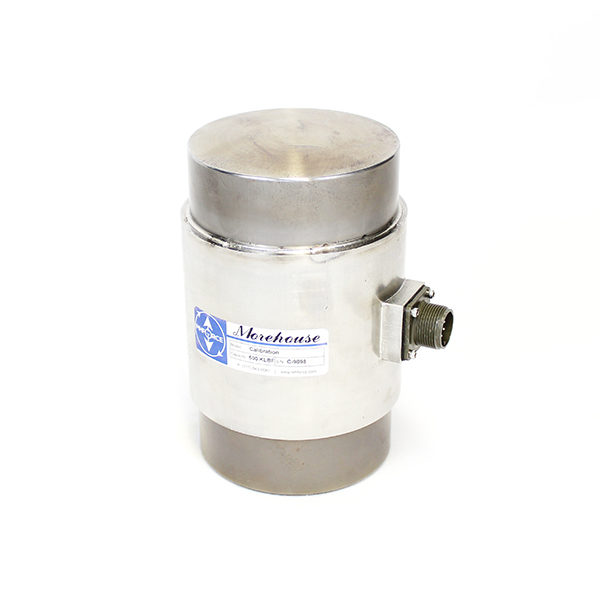
Advantages
- It can be more compact than single-column cells.
- Improved discrimination against the effects of off-axis load components.
- Typically have less creep and better zero returns than single-column cells.
- In many cases, a properly designed shear-web spring element can offer greater output, better linearity, lower hysteresis, and faster response.
Disadvantages
- The design of this load cell requires a top adapter to be purchased with it. Varying the hardness of the top adapter will change the output.
In our next Back-to-Basics blog, I will cover load cell troubleshooting.
Back-to-Basics series:
- Force Calibration and its Importance
- How a Transducer Measures Force
- Compression and Tension Force Calibration
- Calibration versus Verification
- Measurement Uncertainty
- Load Cell Terminology
- Types of Load Cells
- Load Cell Troubleshooting
- Load Cell Indicator Basics
- Force Measurement Glossary of Terms
If you enjoyed this article, check out our LinkedIn and YouTube channel for more helpful posts and videos.
I take great pride in our knowledgeable team at Morehouse, who will work with you to find the right solution. We have been in business for over a century and focus on being the most recognized name in the force business. That vision comes from educating our customers on what matters most, having the right discussions relating to force calibration basics so that everyone speaks the same language.
Everything we do, we believe in changing how people think about force and torque calibration. We challenge the “just calibrate it” mentality by educating our customers on what matters, and what causes significant errors, and focus on reducing them.
Morehouse makes simple-to-use calibration products. We build fantastic force equipment that is plumb, level, square, rigid and provide unparalleled calibration service with less than two-week lead times.
Contact us at 717-843-0081 to speak to a live person or email info@mhforce.com for more information.

